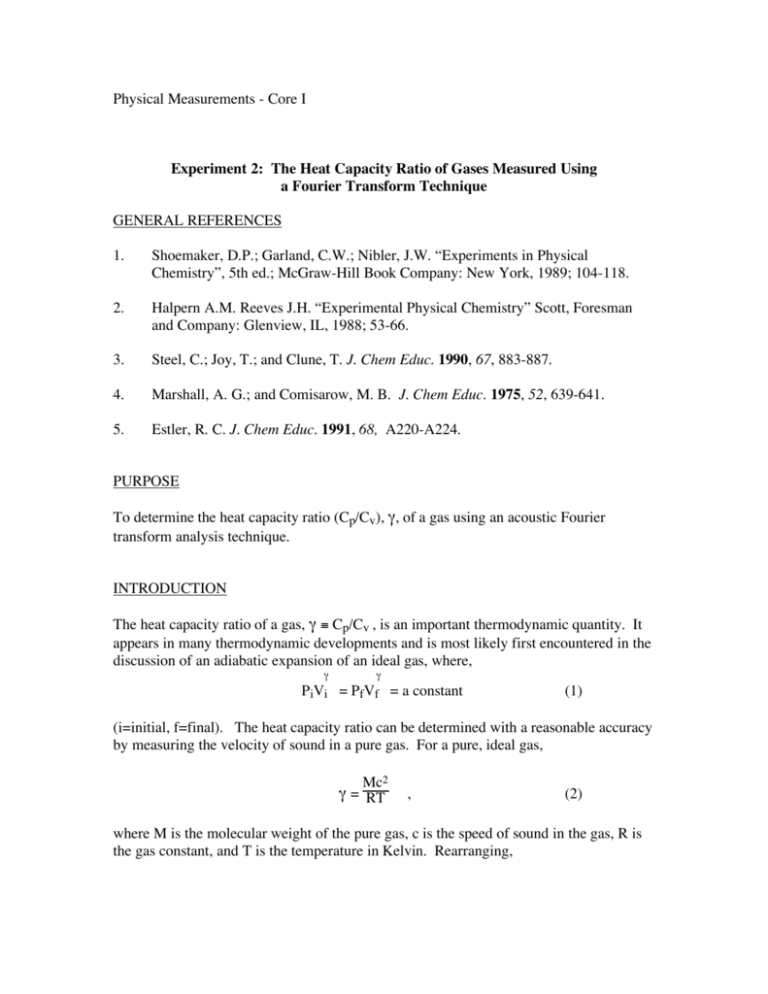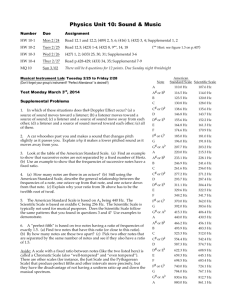The Heat Capacity Ratio of Gases Measured Using a Fourier
advertisement

Physical Measurements - Core I Experiment 2: The Heat Capacity Ratio of Gases Measured Using a Fourier Transform Technique GENERAL REFERENCES 1. Shoemaker, D.P.; Garland, C.W.; Nibler, J.W. “Experiments in Physical Chemistry”, 5th ed.; McGraw-Hill Book Company: New York, 1989; 104-118. 2. Halpern A.M. Reeves J.H. “Experimental Physical Chemistry” Scott, Foresman and Company: Glenview, IL, 1988; 53-66. 3. Steel, C.; Joy, T.; and Clune, T. J. Chem Educ. 1990, 67, 883-887. 4. Marshall, A. G.; and Comisarow, M. B. J. Chem Educ. 1975, 52, 639-641. 5. Estler, R. C. J. Chem Educ. 1991, 68, A220-A224. PURPOSE To determine the heat capacity ratio (Cp/Cv), !, of a gas using an acoustic Fourier transform analysis technique. INTRODUCTION The heat capacity ratio of a gas, ! " Cp/Cv , is an important thermodynamic quantity. It appears in many thermodynamic developments and is most likely first encountered in the discussion of an adiabatic expansion of an ideal gas, where, ! ! PiVi = PfVf = a constant (1) (i=initial, f=final). The heat capacity ratio can be determined with a reasonable accuracy by measuring the velocity of sound in a pure gas. For a pure, ideal gas, Mc2 ! = RT , (2) where M is the molecular weight of the pure gas, c is the speed of sound in the gas, R is the gas constant, and T is the temperature in Kelvin. Rearranging, 1 c= # "RT & 2 % ( $ M ' (3) Note that this equation predicts that the speed of sound is independent of pressure and varies as M-1/2 and T1/2. This M!and ! T dependence is similar to that of the molecular ! velocities predicted in the Kinetic-Molecular Theory of Gases. In fact, to an order of magnitude at ambient temperatures, the speed of sound and molecular velocities are comparable, roughly, 104 cm/s (102 m/s). (Some good numbers to remember). To understand how our particular speed of sound measurement is made, remember that sound propagation represents the compressions and rarefactions of gas molecules along the direction of travel. If we limit our discussion to one dimension (direction) then the distribution of gas molecules along the direction of travel might look something like that shown below. If the above figure represented a real tube, closed at both ends with length L, standing sound waves would be formed in the tube when the tube's length was equal to an integral number of half wavelengths, i.e., L = n#/2 , n=1,2,3,... (4) This is analogous to the standing wave patterns set up in the one dimensional particle-inthe-box problem due to the imposition of the boundary conditions of the walls. Remembering that for any wave-like motion of frequency f, the velocity c, is given by c = #f. It follows that the maximum intensity of sound detected at the opposite end of the tube from the source will occur for those frequencies, f, nc f = 2L . n=1,2,3,... (5) Thus measuring the length of the tube cavity, L, and measuring the frequencies forming standing waves, the speed of sound can be determined for the particular gas. A plot of the those frequencies versus the arbitrarily determined integer n (starting at low frequencies) is predicted from Equation 5 to produce a straight line plot of slope c/(2L). With a known cavity length L, the speed of sound is then determined from the slope. The heat capacity ratio can then be evaluated directly through the application of Equation 2. The first application of this "tube" method by Kundt in the 1860s to determine the speed of sound has resulted in the naming of this device Kundt's tube. Kundt used light, fine powders to locate the compression minima and maxima of the gas as sound propagated down the tube (and thus the wavelengths). The key to the experiment is therefore to accurately determine those frequencies propagating down the tube. Traditionally this is accomplished by connecting an audio signal source to a speaker attached to one end of the Kundt's tube while "listening" at the other end with a microphone. The frequencies of high amplitude (loud) signals are recorded as the frequency is systematically and slowly scanned through the audio region (20-20,000 Hz). Done correctly, this process can be time consuming and many would claim, tedious. An alternative approach to determine these frequencies involves using the power of Fourier Transforms to collect data in the amplitude/time domain and to transform it into the amplitude/frequency domain. This is essentially what your ear/brain combination accomplishes. Your eardrum (and associated additional anatomical parts) records pressure amplitude variations in the air as a function of time. Your brain transforms the resulting time dependent nerve impulses as the sensation of hearing a tone of a given frequency (or mixture of different tones depending on the source). The experimental advantage of Fourier Transforms is one of multiplexing - recording all the pertinent frequency data simultaneously rather than observing only one frequency for a given duration before moving on to the next frequency. In our experiment, all audio frequencies are sent down the tube at once by connecting the speaker to a source of "white noise" (all frequencies present at approximately the same amplitude). The resulting amplitude/time data will be captured by a computer. The frequency spectrum (amplitude vs. frequency) is computed by the computer via the Fast Fourier Transform algorithm (FFT). The resonant frequencies (frequencies of large amplitudes) are then used as outlined above to determine the heat capacity ratio. The power of this technique becomes apparent when you realize that the data required can be recorded in a few seconds for a single spectrum, just several minutes for an averaged spectrum with good a signal-to-noise ratio. THEORY Shoemaker, et al. (1) and Halpern and Reeves (2) develop the thermodynamic theory connecting the heat capacity ratio and the speed of sound within a particular gaseous medium. Steel, et al. (3) provide a good introduction into the process of Fourier Transforms for this experiment while Marshall and Comisarow provide a general introduction to Fourier Transform methods in spectroscopy (4). EXPERIMENTAL & CALCULATIONS Experiment Summary: Our heat capacity ratio determination will be a two-step procedure. We will use argon gas (Ar) as a standard. The heat capacity ratio of Ar can be taken to be equal to 5/3. (Why?) Using this ratio, the temperature of the gas during the experiment and the Ar molecular weight, the speed of sound in argon can be accurately calculated. After determining the resonant frequencies of argon using the data acquisition and transformation procedures given below, use argon's sound velocity to accurately determine the exact length of our particular Kundt's tube. Following this length determination, determine the heat capacity ratio for an "unknown" gas of those suggested. Part A: Cavity Length Determination 1. Record the amplitude/time spectrum of the white noise generator for argon following the procedures given below. Be sure to purge the tube with gas for several minutes before performing the experiment. Record the temperature of the tube. 2. Using the LabView software provided, record the Fourier transform of the amplitude/time spectrum into an amplitude/frequency spectrum for several minutes until you are satisfied with the quality of the signal. Transfer the data to a spreadsheet file to your analysis. The instructor will give you the necessary information about this file’s structure. Your expanded data will look something like that below. 3. Tabulate (in your notebook) the resonant frequencies (i.e., the major, equally-spaced peaks) along with a corresponding integer n, starting with n=1 at low frequencies and numbering sequentially to higher frequencies. 4. In your spreadsheet program, generate a plot of the resonant frequencies vs. the integer n. 5. From the plot's slope, determine the Kundt's tube length using the calculated speed of sound for argon from its "standard" heat capacity ratio and the temperature recorded. Part B: Heat Capacity Ratio Determination of an "Unknown" Gas 1. Repeat Part A, steps 1-4 for your gas, but this time use the cavity length determined in Part A, step 5, to determine the heat capacity ratio for your sample gas. 2. Compare your result of Part B, step1 to that determined by using the Cp found in the TAPP database for your gas at the experimental temperature and the corresponding calculated Cv (remember, Cp - R).






